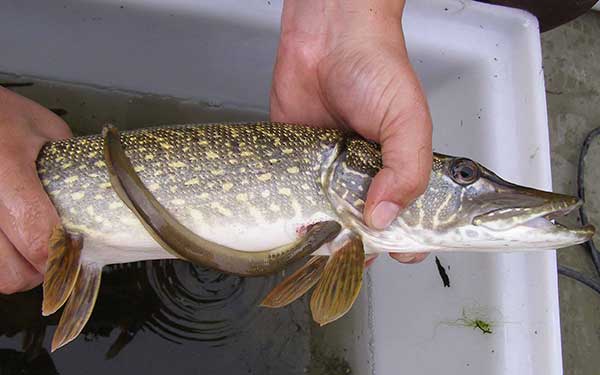By Louie Stout
 Yucky Lampreys are Interesting Creatures
Yucky Lampreys are Interesting Creatures
Several years ago I caught a nice smallmouth while fishing the St. Joseph River east of Elkhart when I saw the most disgusting creature attached to the side of the fish.
Having spent some time fishing trout and salmon in Lake Michigan, I knew immediately what it was.
A lamprey - a slimy, squirmy, eel-like creature with a suction mouth attached to the body of the bass.
Of course, my reaction was to call the Indiana DNR and report sea lampreys had ventured well up the St. Joe. Sea lampreys are a non-native creature that trout and salmon fish managers have spent millions trying to eradicate in Lake Michigan tributaries.
Perhaps you have encountered a similar experience and were as utterly repulsed as I was.
However, the biologist reassured me that what I saw was not the notorious sea lamprey, but likely a native chestnut lamprey. He said the prehistoric looking creatures have been around for millions of years and it’s not unusual to encounter one stuck to a fish in Michiana rivers and streams.
Elkhart/South Bend aquatic biologist Dar Deegan says they are not only fairly common, but actually a pretty cool creature to see in a river system. They also exist in some lakes.
“Sure they are a nasty looking, blood sucking fish, but they also are quite interesting and a sign of good water quality,” said Deegan this week. “You just don’t find many in polluted waters, and they are not the sea lamprey variety.”
Deegan is fascinated by lampreys and has taken an added interest in studying them while doing his on-water surveys of the St. Joe and its tributaries.
There are four species in area streams, two of which are parasitic (chestnut and silver) and two which are not (northern brook and American brook). The non-parasitic lampreys, which feed on algae and plankton, are even more vulnerable to poor water quality.
As adults, the chestnut and silver lampreys attach their suction-like mouths onto a fish and feast on its blood.
The St. Joe variety rarely exceeds 10 inches while the sea lamprey in Lake Michigan grows to two feet or more.
And while sea lampreys can - and do - kill the host fish, the smaller native versions typically don’t, unless multiple creatures attach to a single fish.
“The native variety isn’t big enough to cause harm to most fish,” says Deegan. “They drain just enough energy to survive and yet keep the host fish healthy.”
Deegan finds most lampreys on carp and suckers although they will attach to gamefish when the opportunity presents itself. Deegan says he finds them only on the fatter, juiciest fish and rarely on smaller fish.
They do so by grabbing the fish with their suction cup mouths, then grind sandpaper-like teeth onto the fish so that they can penetrate the skin and feed on its blood supply.
They will attach to a fish and can stay on it throughout the summer and into the winter, Deegan added.
They thrive best in slack water areas or backwaters of a stream, lounging around the bottom until an unsuspecting fish comes along.
Their life cycle is equally fascinating. Adults will spawn in sandy, gravelly stream bottoms by using their suction mouths to move rocks around to build nests similar to a bluegill nest. When the eggs hatch, the larvae digs into the bottom where it remains for four or five years until it metamorphoses into an adult. During its early years, the lamprey will poke its head out of the bottom and feed on tiny aquatic organisms.
“When we’ve run our shocker boat (for gathering fish samples) we’ve seen them shoot out of the bottom and then quickly burrow themselves back into it,” said Deegan.
You’ll be relieved to know they are not harmful to humans. While giving educational talks to the public, Deegan has attached lampreys to himself and even some kids who are willing to participate.
“It’s difficult to get them to attach to humans, and if they do, they let go fairly quickly,” said Deegan. “They obviously don’t like the taste of people.”
And for those who like to wade streams and swim in rivers and streams, that is very good news.


